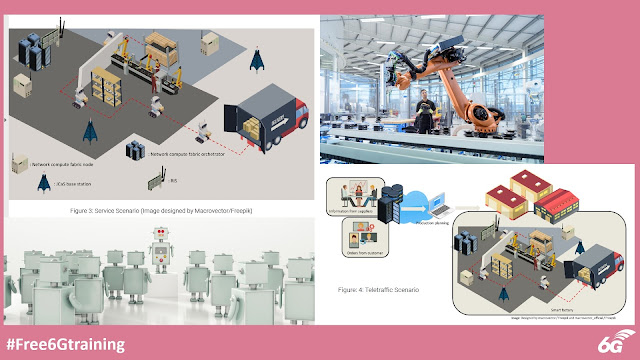The whitepaper outlining Orange's vision for 6G highlighted the role of 6G in robotics and autonomous systems of the future. Quoting from the paper:
Robotics and autonomous systems, such as drones, in industrial plants and beyond represent a prominent class of 5G use cases. Thanks to enhanced reliability and reduced latency, 5G covers both consumer and vertical sector markets, thereby becoming a viable solution to connect machines with tight service constraints. 6G is expected to confirm this trend and to enable a change of scale in order to handle traffic growth and an increased number of devices and machines, as well as tackle the resulting increase in complexity and the number of simultaneous constraints.
Further reduced latency may be needed to ease the coexistence of robots and human workers sharing the same space (the so-called cobots). Better communication with and between robots also enables easier adaptation of production lines to limited series, reducing failures and also energy and material wastage. Robots can also substitute humans to perform dangerous tasks.
Usage of robots may be generalized beyond the industrial area, with an increasing presence at home and in everyday life, beyond the current usages of lawn mowing or vacuum cleaning. This generalization can support usages beneficial for society and the environment. They can improve the well-being of people, e.g., by facilitating the everyday life of people with physical impairment when deployed at home, or contribute to maintain elderly persons at home with robots dedicated to their care.
Back in summer, ATIS' Next G Alliance (NGA) published a report on Network-Enabled Robotic and Autonomous Systems. The report provided an introduction to robots and why we need them, highlighted the 3GPP standardisation activities related to them, and then looked at:
- Delivery Robots
- Autonomous Driving
- 'Cobots' (collaborative robots) in smart factory
- Societal impacts of 'Sobots' (Service Robot)
It concluded with a section on 'Conclusion and Recommendations'. Quoting from this section:
The success of robotics and autonomous systems largely depends on their ability to communicate with one another and with humans and for a group of robots and robotic applications to gain connected intelligence to handle increasingly complex problems.
However, the development of advanced communication systems to support robotics and autonomous systems also presents challenges. In cyber-physical systems, security and privacy are major concerns, particularly in applications such as transportation and manufacturing that require a very high level of resilient operations because these systems may be vulnerable to cyberattacks. It is also important to ensure these systems are reliable and do not pose any risk to humans. In addition, there is a need for standardized communication protocols to ensure interoperability among different systems and access technologies.
The success of robotics and autonomous systems will largely depend on the development of advanced communication systems to support these technologies. This development preliminarily requires careful investigation into what the potential users and customers would really need in various settings of their living environments. From everyday living to transportation to industrial manufacturing, intelligent compute and communication between systems and humans is crucial to ensure safety, efficiency, accuracy, privacy, and resilience.
Our team at #InterDigital recently contributed to the @NextGAlliance report on #6G Technologies for the Wide Area #Cloud Evolution, highlighting the important role of integrating computing and communications. Kudos to our contributors!
— InterDigital (IDCC) (@InterDigitalCom) June 21, 2023
Read more here: https://t.co/gzCEORjnNp
Another whitepaper by ATIS, with contributions from Interdigital over the summer looked at '6G Technologies for Wide Area Cloud Evolution'. Quoting from the paper:
The Next G Alliance report '6G Distributed Cloud and Communication Systems' provides a high-level overview of the promises, trends, and challenges in the convergence of mobile communications and cloud computing. It introduces the concept of the 6G wide-area cloud (WAC). This paper takes a deeper dive into the concept of the 6G WAC and provides a more in-depth analysis of some of the key aspects that need to be addressed when integrating cloud and communications. For each of these areas, the key research challenges are further explored.
What is the 6G WAC? This is often interpreted in two ways:
- The integration of cloud concepts into the 3GPP network. The goal here is usually to make the mobile networks more efficient, reliable, and cost-effective, but not necessarily to provide new compute services. This is a path that 3GPP started in 5G.
- Leveraging the mobile network to integrate distributed computing resources for richer and more dynamic cloud services to applications.
In reality, these should not be viewed as separate outcomes but rather points along a journey with an end goal of integrating communications and compute to meet the demands of new applications. These applications need to communicate with the outside world, process application data, and interpret the data.
The 6G network can be envisioned as a vast array of sensors, users, applications, and services that will both produce and consume vast amounts of data. That data will pass through various jurisdictional, business, and geopolitical domains. The network must ensure that the QoS requirements for accessing and processing this data are met. It must also ensure that the privacy, security, and legal constraints on the data are met, both when the data is at rest and on the move. In addition, the 6G WAC must provide a cloud framework that works in tandem with the 6G communication systems, enabling distributed applications to be deployed using resources of multiple public, private, and hybrid clouds.
You can get all of Next G Alliance report and whitepapers here.
Related Posts:
- Free 6G Training: New White Paper Outlines Orange's Vision for 6G
- Free 6G Training: Next G Alliance (NGA) Report on '6G Roadmap for Vertical Industries'
- Free 6G Training: Next G Alliance's Report on 6G Applications and Use Cases
- Free 6G Training: ATIS’ Next G Alliance (NGA) Releases Two New Reports
- Free 6G Training: Transatlantic perspectives on 6G Vision, Roadmap and Development Model



Comments
Post a Comment